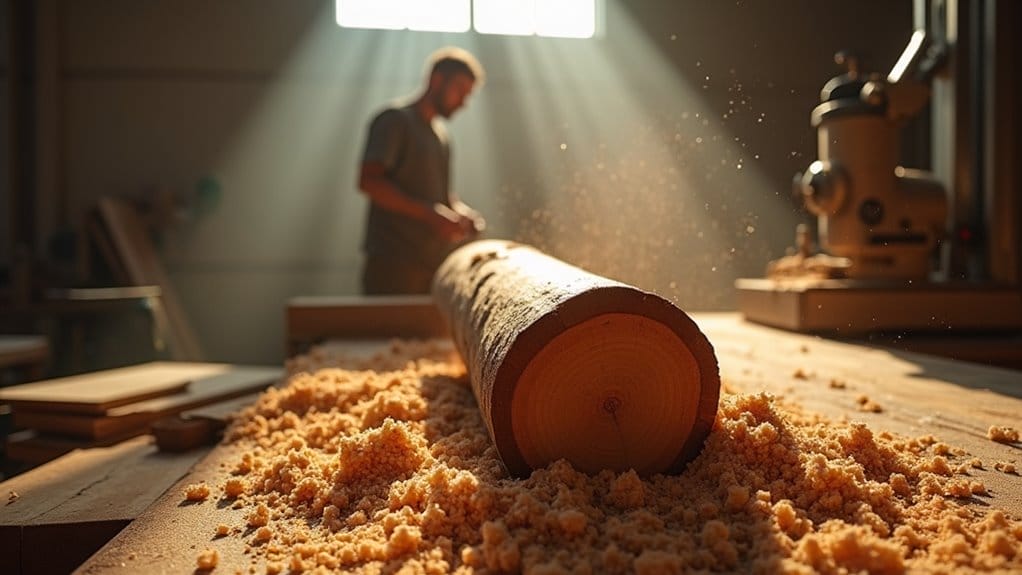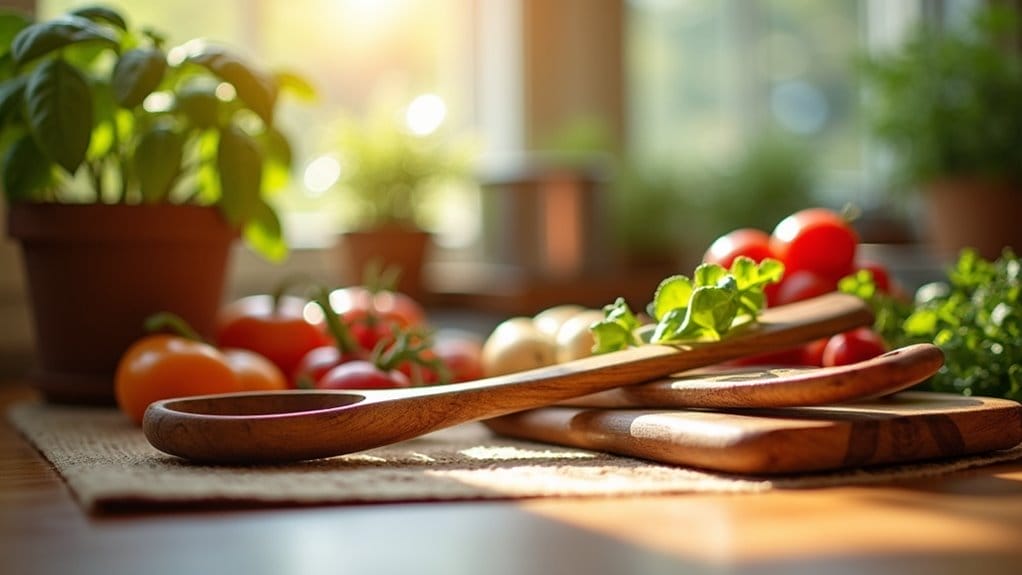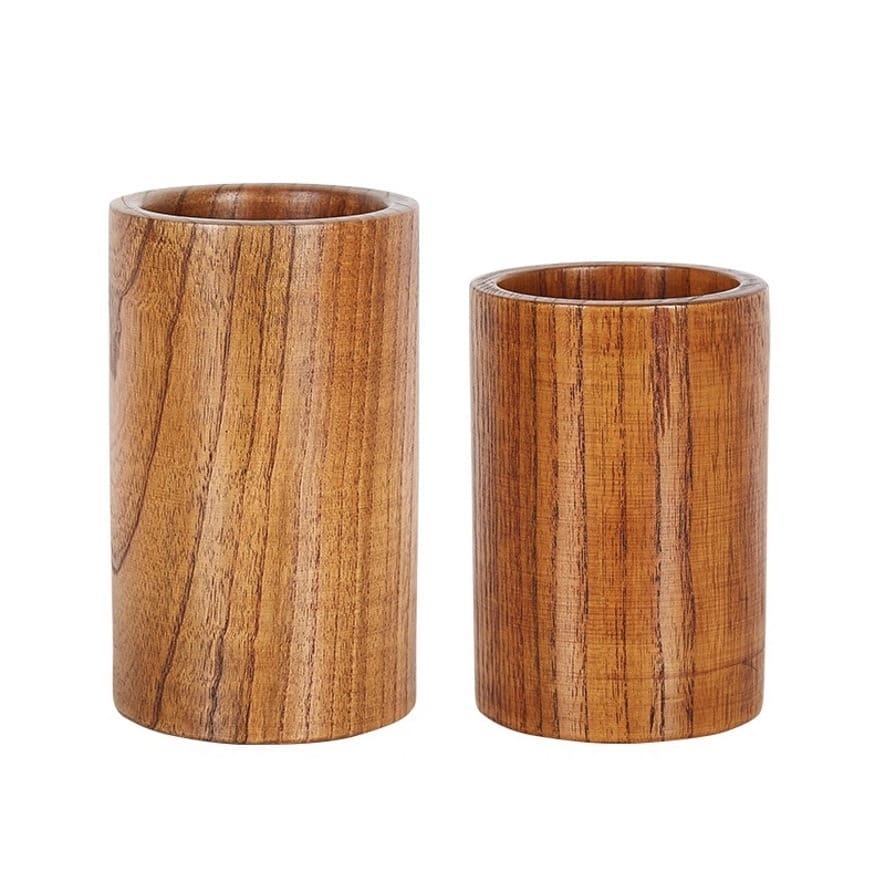When you explore the wood manufacturing process, you’ll uncover a precise journey that starts with sustainable tree harvesting. Each step, from initial grading to treatment, is designed to enhance the wood’s quality and durability. Understanding these processes is essential, as they guarantee the final product meets rigorous standards. But have you considered the impact of each decision made along the way on both the environment and consumer trust?
Key Takeaways
- Selecting quality trees involves assessing their age, health, and environmental impact to ensure sustainability and forest health.
- Initial processing includes grading logs for defects and moisture content to maximize material utility and product integrity.
- Wood treatment methods, such as chemical preservation and kiln drying, enhance longevity and prevent warping or decay.
- Final transformation processes like sanding and finishing improve aesthetics and functionality, ensuring products meet specifications.
- Strict grading criteria guarantee quality assurance, preventing substandard products and building consumer trust in wood items.
Harvesting the Trees

When you begin the harvesting process, selecting the right trees is essential for both quality and sustainability.
You’ll consider factors like age, health, and environmental impact to guarantee responsible practices.
Employing sustainable harvesting techniques not only meets demand but also maintains the forest ecosystem for future generations.
Tree Selection Criteria
The selection criteria for harvesting trees involve a meticulous assessment of several factors to guarantee sustainable practices and ideal timber quality.
You’ll want to take into account tree selection based on age, health, and species diversity to guarantee renewable resources. Sustainability plays a vital role in forest management, so evaluate environmental factors that impact growth and regeneration.
Adhering to certification schemes like FSC® or PEFC assures you of ethical sourcing. By prioritizing these criteria, you contribute to responsible harvesting practices, helping maintain biodiversity while securing high-quality timber.
A well-thought-out selection process is essential for the long-term health of our forests.
Sustainable Harvesting Techniques
Building on the importance of careful tree selection, sustainable harvesting techniques focus on responsible methods for felling trees while maintaining forest health.
These practices involve selectively harvesting trees, ensuring the ecosystem remains intact, and allowing new growth to flourish. Sustainable forestry management emphasizes the balance between timber production and environmental conservation, adhering to certification standards like FSC® and PEFC.
Initial Processing

Once you’ve harvested the trees, the grading process begins to assess the quality of the logs.
You’ll transport these logs to the mill, where they’ll undergo initial processing, including debarking and sawing.
This critical stage sets the foundation for transforming raw wood into usable timber products.
Grading the Logs
Grading logs is a crucial step in the initial processing of wood, as it directly affects the quality and value of the final timber products.
During grading, you’ll assess logs for various factors:
- Defects: Evaluate for knots, cracks, and other imperfections.
- Moisture Content: Measure to guarantee ideal drying, impacting the durability of lumber.
- Quality Assurance: Confirm logs meet industry standards for transforming into wood products.
Proper grading guarantees you’re maximizing the utility of the material while maintaining the integrity of the finished products.
This process lays the groundwork for high-quality lumber ready for further processing.
Transportation to the Mill
Efficient transportation of logs to the mill is a vital step in the initial processing of wood, ensuring timely processing and maintaining quality.
During this phase, logs must be transported swiftly from the forest, carefully considering moisture levels. Controlled transportation helps minimize exposure to humidity and temperature fluctuations, which can affect the wood’s integrity.
The stages involved, such as loading, hauling, and unloading, must adhere to protocols that prioritize the quality required for lumber drying.
Milling the Wood

In the milling process, you’ll employ cutting and sawing techniques to transform rough lumber into usable boards.
These methods maximize yield while ensuring precision, setting the stage for planing the wood to achieve uniform width and thickness.
Cutting and Sawing Techniques
The milling process is essential for transforming logs into usable timber products, employing various cutting and sawing techniques to maximize yield and efficiency.
Key methods include:
- Head Rig Sawing: This cuts debarked logs into rough cants, optimizing lumber yield by minimizing defects.
- Edging: This edges the cants and trims the sides, creating squared lumber while removing defects.
- Shaping: This involves further refining the lumber to specific dimensions, ensuring uniformity.
Planing the Wood for Uniformity
Planing the wood is crucial for achieving uniformity in dimensions and surface texture, guaranteeing the finished product meets specific standards.
During this process, specialized machinery performs planing to create a smooth, uniform thickness across the wood. This step eliminates surface defects while improving the overall quality, allowing for better finishing and enhanced aesthetics.
You’re effectively smoothing the wood using precision tools that remove irregularities. The outcome is a consistent appearance, essential for applications in furniture and cabinetry.
Treatment of the Wood

In treating wood for longevity and performance, you’ll encounter methods like chemical preservation and heat treatment.
Chemical treatments, such as pressure treatments, effectively guard against pests and decay, while heat treatment further enhances wood’s durability by altering its cellular structure.
Additionally, proper drying processes are essential to reduce moisture content, preventing warping and ensuring stability in the final product.
Chemical Treatments for Preservation
While wood is a naturally durable material, applying chemical treatments for preservation greatly enhances its longevity and performance, particularly in outdoor settings.
These treatments help prevent decay and extend the life of wood, especially if it’s unseasoned.
Key considerations for effective chemical treatments for preservation include:
- Selecting Appropriate Treatments: Choose the right solutions based on the intended use and exposure.
- Quality Assurance: Verify proper application during the drying process to achieve ideal results.
- Longevity of Finished Product: Confirm the treatment enhances durability and maintains appearance over time.
Heat Treatment and Drying Processes
Understanding the heat treatment and drying processes is essential for enhancing the performance and durability of wood products.
This process of turning raw wood into usable materials involves controlled kiln drying to effectively remove moisture. By reducing the moisture content, you can prevent defects such as warping and cracking.
Heat treatment, additionally, enhances wood’s resistance to pests and decay. These processes guarantee the wood achieves ideal performance in various applications.
Maintaining precise temperature and humidity levels during drying maximizes quality, assuring the wood withstands environmental challenges while meeting industry standards.
This attention to detail is key to superior wood manufacturing.
Final Transformation

In the final transformation stage, you’ll shape and finish the wood products to meet specific designs and standards.
This process includes meticulous quality control and grading to ascertain each piece meets the desired specifications for strength and aesthetics.
Proper attention during this phase guarantees that your wood products perform reliably in their intended applications.
Shaping and Finishing the Product
Shaping and finishing the product involves a meticulous transformation process that enhances wood’s functionality and aesthetic appeal.
During this stage, machines play a vital role in achieving the desired specifications through precise machining. Here are key aspects of shaping and finishing:
- Sanding: This process smooths the wood surface, ensuring an even texture.
- Staining: Applying stains enriches the color and protects the wood, making it more visually appealing.
- Final finish: Protective coatings enhance durability, especially for furniture, safeguarding against wear and environmental factors.
These steps are essential for delivering a high-quality, finished product that meets consumer expectations.
Quality Control and Grading
As the final transformation of wood products approaches, quality control and grading become critical components that directly influence their market value and usability.
You’ll assess each batch to determine its grade, taking into account the wood’s appearance, strength, durability, and any visible defects or imperfections. Higher grades boast minimal defects, making them suitable for high-end applications, while lower grades may have larger knots and surface flaws.
Implementing strict quality control measures guarantees compliance with industry standards, providing confidence to both manufacturers and consumers.
This meticulous process assures that every piece of wood meets the desired specifications before reaching the marketplace.
Frequently Asked Questions
What Sustainable Practices Are Used in Tree Harvesting?
In sustainable tree harvesting, you guarantee responsible practices by selecting trees based on health and age, using efficient methods, and prioritizing certified sources like FSC® to help maintain forest ecosystems and promote biodiversity.
How Do Certification Schemes Impact Wood Sourcing?
Certification schemes enhance wood sourcing by ensuring you select ethically sourced timber. They verify environmental standards and sustainable practices, helping you make informed choices while supporting responsible forest management and promoting long-term ecological balance.
What Types of Wood Are Best for Different Projects?
For different projects, hardwoods like oak and maple suit furniture due to durability, while softwoods like pine and cedar work well for framing and outdoor applications. Consider your project’s specific needs for ideal wood choice.
How Can Consumers Verify the Quality of Wood Products?
You can verify wood quality by checking for grading certifications, examining moisture content, and looking for manufacturer details. Certifications like FSC® or PEFC guarantee ethical sourcing, while visual inspections highlight the product’s overall appearance and durability.
What Environmental Impacts Result From Deforestation?
Deforestation leads to biodiversity loss, habitat destruction, and increased carbon emissions. You’ll notice altered ecosystems, soil erosion, and disrupted water cycles, ultimately impacting climate, wildlife, and human health. Sustainable practices are essential for mitigating these effects.
Conclusion
In summary, understanding the wood manufacturing process from forest to finished product is essential for appreciating the craftsmanship behind quality wood products. By following sustainable harvesting practices, meticulous processing, and rigorous treatment methods, you’re not only enhancing durability and aesthetic appeal but also supporting ecological balance. Each step, from initial processing to final transformation, reflects the commitment to quality and safety standards that ultimately build your trust in wood products.






































